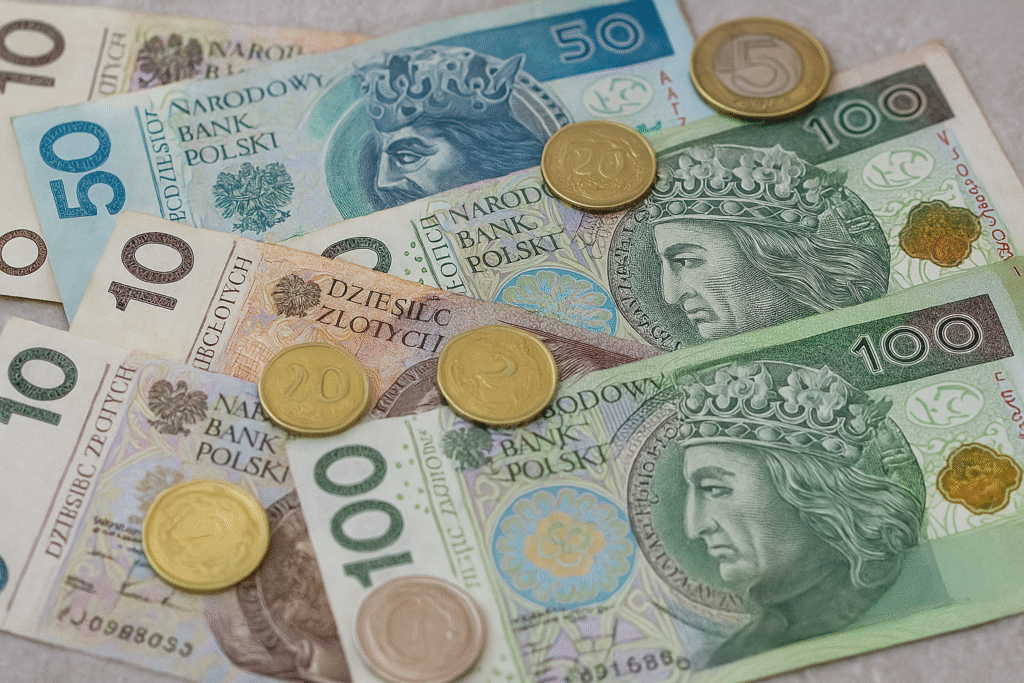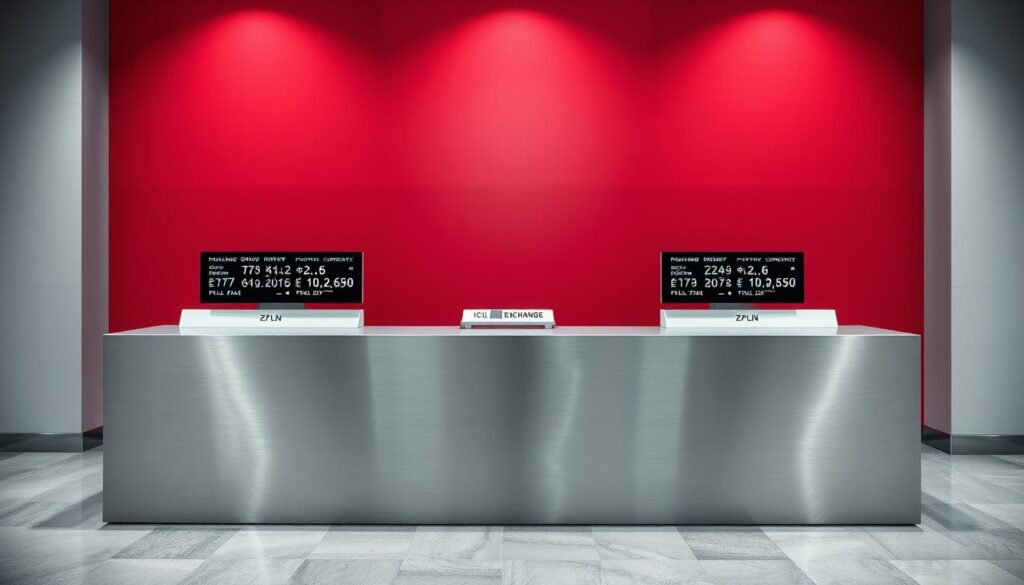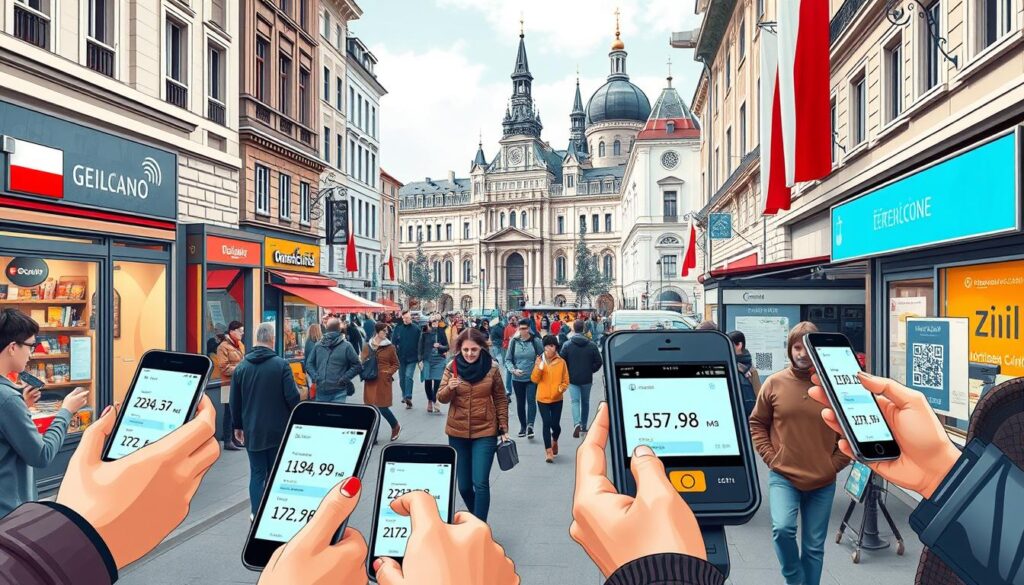
The Polish Zloty (PLN) is key to Poland’s economy. It’s used in all financial dealings. Knowing the Zloty is important for anyone in Poland, whether traveling, working, or investing.
The Zloty, or PLN, is split into 100 groszy. It’s Poland’s only legal money. Understanding it helps you move around Poland’s financial world.
Key Takeaways
- The Polish Zloty (PLN) is Poland’s official currency.
- It is divided into 100 groszy.
- Understanding the Zloty is vital for financial transactions in Poland.
- The Zloty is used by over 38 million people in Poland.
- Knowledge of the Zloty is key for travel, business, and investment in Poland.The Polish Zloty: What Is Polish Currency?
Poland’s official currency is the Zloty, marked by the symbol ‘zł’ and known globally by its ISO code PLN. The Polish Zloty is not just the legal tender in Poland. It also plays a big role in the regional currency market.
Official Status and ISO Code
The Polish Zloty is the official money in Poland, managed by the National Bank of Poland. Its ISO code, PLN, helps with international trade and travel. This code makes it easier to deal with the currency worldwide.
| Currency | ISO Code | Symbol |
|---|---|---|
| Polish Zloty | PLN | zł |
Etymology and Meaning of “Złoty”
The word “Złoty” means “golden” in English. This shows its historical roots. The name connects to the past when coins were made from gold. It adds cultural value to the currency, showing wealth and prosperity.
“The name ‘Złoty’ is a testament to Poland’s rich history and its connection to the precious metal that once backed its currency.”
Position in the Global Currency Market
The Polish Zloty is a top currency in Central and Eastern Europe. Its value is affected by Poland’s economy, politics, and EU ties. The Zloty floats on the foreign exchange market, meaning its value changes based on market forces.
The Polish Zloty is key for international trade and investment in the region. Knowing its market dynamics is vital for those doing business with Poland.
Historical Evolution of Polish Currency
Poland’s currency has a long and varied history. It has seen big changes in medieval times, the communist era, and after 1989. Knowing how the Polish złoty evolved helps us understand Poland’s economic past and present.
From Medieval Times to World War II
The first coins in Poland were made in the early 11th century. Over time, the currency changed a lot. This was due to trade, politics, and wars. The złoty we know today started in 1924, after Poland got its freedom back after World War I.
World War II was hard on Poland’s economy. It led to high inflation, making the złoty worth less. The war also brought in emergency currencies and messed up normal money use.
“The economic consequences of World War II for Poland were severe, with significant damage to its economy and a substantial loss of national wealth.”
Communist Era Currency
After World War II, Poland became a socialist state under the Soviet Union. The currency was tightly controlled by the state. The National Bank of Poland was key in setting money policies.
The communist era had a planned economy. This affected the złoty’s value and use. The exchange rate was set by the state, not the market. This caused problems with the official and black market rates.
| Period | Currency Characteristics | Economic Conditions |
|---|---|---|
| Medieval Times | Introduction of first coins | Feudal economy, trade influence |
| Communist Era | State-controlled currency | Planned economy, fixed exchange rates |
| Post-1989 | Currency reforms, redenomination | Transition to market economy, inflation control |
Post-1989 Currency Reforms
The fall of communism in 1989 changed Poland’s economy and currency. The early 1990s had high inflation, leading to big reforms. In 1995, the złoty was redenominated, making it easier to use.
After 1989, Poland joined the global economy. It became part of the European Union in 2004. These steps made the złoty more stable and useful.
The Polish złoty’s history shows Poland’s complex past. From old coins to today’s currency, it has changed a lot. These changes were influenced by many events and policies.
The National Bank of Poland (Narodowy Bank Polski)
Narodowy Bank Polski is Poland’s central bank. It manages the country’s money and currency. This job is key to keeping the economy stable and the Polish Zloty (PLN) strong.
Structure and Governance
The National Bank of Poland has a clear structure. This ensures it works well and stays independent. A Monetary Policy Council sets the bank’s policies, like interest rates. This council fights inflation and keeps the economy stable.
The bank also has a President. The President of Poland picks this person. The President of the National Bank leads the bank and sets its direction.
Monetary Policy and Currency Management
The main goal of Narodowy Bank Polski is to keep prices stable. It does this by making monetary policy decisions. The bank uses tools like interest rates to control money and fight inflation.
The bank also looks after the Polish Zloty. It makes sure the currency is stable and works well. The bank fights against fake money and keeps the currency real.
Comparison with the Federal Reserve System
The National Bank of Poland is similar to the Federal Reserve System in the U.S. Both manage money and keep the economy stable. But, they have different ways of doing things.
Like the Federal Reserve, the National Bank of Poland makes its own money decisions. But, it also follows Poland’s economic plans and works with European finance.
Denominations of the Polish Zloty
The Polish Zloty has various banknotes and coins for different needs.
Banknotes in Circulation
The Polish Zloty banknotes come in several denominations. You’ll often see 10, 20, 50, 100, and 200 PLN. Each has its own design and security features to fight counterfeiting.
Polish Coins and Their Values
Coins are a big part of the Polish Zloty. You can find 1, 2, 5, 10, 20, and 50 groszy coins, plus 1, 2, and 5 PLN. They show the Polish eagle and other symbols.
The Grosz Subunit
The grosz is the smaller unit of the Polish Zloty, with 100 groszy making 1 PLN. Groszy coins are around, but their value has gone down because of inflation.
Commemorative and Collector’s Coins
The National Bank of Poland makes special coins for big events. These coins are loved by collectors for their unique designs and precious metals.
| Denomination | Type | Material |
|---|---|---|
| 1 grosz | Coin | Copper-plated steel |
| 10 PLN | Banknote | Paper |
| 5 PLN | Coin | Brass |
| 50 PLN | Banknote | Paper |
Knowing the Polish Zloty’s different denominations helps locals and tourists with everyday money matters.
Security Features of Polish Banknotes
The National Bank of Poland has added many security features to Polish banknotes. These features help spot real money and keep the financial system trustworthy.
Anti-Counterfeiting Measures
Polish banknotes have advanced security steps. They include watermarks, holograms, and microprinting. These are hard to fake, making the money safe from counterfeits.
“The National Bank of Poland keeps updating our banknotes’ security,” an official said. This shows how important it is to fight against fake money.
How to Identify Authentic Polish Currency
To check if a Polish banknote is real, look for a watermark. Check the hologram for any fake signs. Also, feel the paper for special textures. And, check the serial number for any oddities.
- Look for watermarks when holding the banknote up to light.
- Observe the hologram for color-shifting and 3D effects.
- Feel the raised printing on the banknote.
Recent Updates to Security Features
The National Bank of Poland keeps improving the security of Polish banknotes. They’ve added better holograms and new watermarks. These changes help keep the Polish zloty safe for the future.
As fake money tricks get smarter, so do the security features. The National Bank of Poland is committed to keeping the Polish currency safe.
Current Exchange Rates and Value
The exchange rates for the Polish Zloty are influenced by many global and local economic indicators. It’s important to understand these factors to predict how exchange rates will move.
PLN to USD Conversion
The Polish Zloty (PLN) to US Dollar (USD) conversion rate is closely watched in Central Europe. The latest data shows the exchange rate is about 1 PLN = 0.25 USD.

This rate can change due to many economic factors. These include decisions by the National Bank of Poland and global market trends.
Historical Exchange Rate Trends
The Polish Zloty has seen big changes against the USD over the years. Here’s a table showing the exchange rate trends for the last five years:
| Year | Average Exchange Rate (1 PLN to USD) |
|---|---|
| 2018 | 0.28 |
| 2019 | 0.26 |
| 2020 | 0.25 |
| 2021 | 0.27 |
| 2022 | 0.24 |
The table shows the exchange rate has changed over time. This is due to economic conditions and global events.
“The Polish Zloty exchange rate is influenced by a combination of domestic economic indicators and global market trends.”
Factors Affecting the Zloty’s Value
Several factors affect the Polish Zloty’s value. These include:
- Economic indicators such as GDP growth and inflation rates
- Monetary policy decisions by the National Bank of Poland
- Global commodity prices
- Political stability and geopolitical events
These factors make the PLN exchange rate dynamic. It’s key for stakeholders to stay updated.
Currency Exchange Options in Poland
Poland offers many ways to exchange currency, from banks to online services. You can pick from banks, kantors, ATMs, or online services. Each has its own benefits and things to watch out for.
Banks vs. Kantors (Exchange Offices)
Banks and kantors are key places for exchanging money in Poland. Banks are safe and rates are good, but they might charge more and have short hours. Kantors, being specialized, often have better rates and are open longer.
Comparison of Banks and Kantors:
| Feature | Banks | Kantors |
|---|---|---|
| Security | High | Variable |
| Exchange Rates | Competitive | Often more favorable |
| Operating Hours | Limited | Extended |
| Fees | May have higher fees | Generally lower fees |
ATM Withdrawals for American Tourists
Using ATMs is a handy way to get Polish złoty. Many ATMs in Poland connect to global networks. But, watch out for foreign transaction fees and exchange rate margins.
Online Currency Exchange Services
Online currency exchange services are easy to use before or during your trip. They usually have better rates and lower fees than banks. But, pick trusted services to avoid scams.
Airport Exchange Rates: What to Expect
Airport exchange offices often have worse rates than city centers. Be careful when exchanging a lot of money at airports. It’s better to exchange a little for immediate needs and find better rates elsewhere.
Knowing about Poland’s currency exchange options helps visitors manage their money well during their stay.
Using Polish Currency as a Tourist
Visiting Poland means getting used to the Polish zloty. Knowing about the local money and how to pay can make your trip better. It makes your stay more fun and less stressful.
Cash vs. Card Payments in Poland
Poland is moving towards digital payments, but cash is key in smaller towns and old places. Big cities like Warsaw, Krakow, and Gdansk accept Visa and Mastercard. But, it’s smart to carry some Polish zloty (PLN) for small buys or rural visits.
Card payments are common in cities, with many places taking contactless payments. You can use your card to buy things or get cash from ATMs. Just remember, your bank might charge extra for foreign transactions.
Tipping Customs and Practices
Tipping in Poland is less than in the US. It’s usual to tip 10% in restaurants and cafes. Tipping bartenders and taxi drivers is nice but not required.
Leaving a small tip on the table or rounding up the bill is common. For tour guides, 10-20 PLN per day is a good tip, based on service quality.
Price Levels Compared to the US
Poland is pretty affordable for tourists, with prices lower than in Western Europe and the US. A meal in a mid-range restaurant costs 20-50 PLN (about $5-$12 USD) per person.
Hotel prices vary by city and type. A budget hotel night costs 100-200 PLN (around $25-$50 USD).
Currency Needs for Different Polish Cities
Major cities like Warsaw and Krakow prefer card payments. But, smaller towns and rural areas often use cash more.
Be ready to use cash in local markets, small shops, and traditional restaurants, even in big cities.
Digital Payment Systems in Poland
Poland is moving towards digital payments, with unique solutions like BLIK leading the way. This change is thanks to new financial tech and what people want.

BLIK and Other Local Payment Methods
BLIK has changed how people pay in Poland. It lets users make quick payments with a six-digit code. Polish banks created it, and now many places accept it.
Other digital payment options are also growing. They include online banking and new fintech solutions. This gives people more ways to pay online.
Key Features of BLIK:
- Instant payment processing
- Security through six-digit code authentication
- Wide acceptance across Poland
Credit Card Acceptance Throughout Poland
Credit cards are common in Poland, more so in cities and tourist spots. Places like restaurants and shops take Visa and Mastercard.
But, it’s smart for visitors to carry some Polish money too. This is because not all places take cards, even in cities.
Mobile Payment Options
Mobile payments are getting popular in Poland. People use Apple Pay, Google Pay, and Samsung Pay. These services are easy and safe, thanks to smartphones.
Mobile payments are also quick because of Poland’s growing contactless system. This makes paying faster and easier.
Benefits of Mobile Payments:
- Convenience and ease of use
- Enhanced security features
- Rapid transaction processing
Contactless Payment Infrastructure
Poland is investing in contactless payments. Many shops now use systems that let you pay by tapping your card or phone.
This system works with cards and mobile payments. It makes paying faster and more convenient.
As Poland’s digital payments grow, visitors will find it easy to pay. It’s a mix of old money and new tech.
Common Currency Exchange Pitfalls to Avoid
Traveling to Poland means knowing the risks of currency exchange. Tourists often face unfair rates without realizing it. This can lead to losing a lot of money.
Tourist Traps and Scams
Scams and bad exchange rates are big risks for tourists. Some exchange offices in tourist spots offer terrible rates. Always check the exchange rate before you exchange money.
- Watch out for exchange offices with too-good-to-be-true rates, they might be scams.
- Always compare the rate they offer to the current market rate.
- Know the fees you’ll pay for the exchange.
Dynamic Currency Conversion (DCC)
Dynamic Currency Conversion lets you pay in your home currency. But, it often has unfavorable exchange rates and extra fees.
To avoid DCC problems:
- Don’t choose DCC when you can.
- Be ready for some ATMs and merchants to default to DCC.
- Use ATMs from your bank to cut down on fees.
Best Practices for Money Exchange
Here are tips for getting a good deal on currency exchange:
- Choose reputable exchange services or banks.
- Avoid exchanging money at airports or tourist spots.
- Use a currency converter app to keep up with rates.
Emergency Currency Situations: What to Do
Having a plan for emergencies can save you money. If you have counterfeit money or were scammed:
- Call your bank or credit card company right away.
- Tell the local police about the scam.
- Have a backup plan, like extra money on a credit card or another debit card.
Being informed and careful can help tourists deal with currency exchange in Poland. This way, they can enjoy their trip more.
The Future of Polish Currency
Poland’s currency is set for a big change. This is due to both the country’s own economic plans and the influence of the European Union. As an EU member, Poland might switch to the Euro. But when this will happen is not clear yet.
Euro Adoption Plans and Timeline
Switching to the Euro is a big task. Poland must meet certain economic standards first. Even though Poland wants to join the Eurozone, when this will happen is being talked about.
The National Bank of Poland thinks it could happen soon. They say it depends on Poland meeting some economic conditions.
Public Opinion on Currency Change
People in Poland have mixed feelings about the Euro. Some see it as a good thing. They think it will make traveling and trading in the EU easier.
But others are worried. They fear losing control over their money and possible economic problems.
Economic Implications of Euro Adoption
Switching to the Euro could change Poland’s economy a lot. It might affect trade balances and bring risks from the Eurozone’s economic issues.
Yet, being in the Eurozone could also bring more foreign investment. It could make trading with other EU countries simpler.
The Zloty in the Digital Currency Era
The rise of digital currencies brings both chances and challenges for the złoty. Digital payments are getting more popular. But the złoty is key to Poland’s financial world.
The National Bank of Poland is looking into digital currency options. This could change how we see the złoty in the digital age.
Conclusion
The Polish Zloty, or PLN, is Poland’s official currency. It has a rich history and plays a big role in the country’s economy. Knowing about Polish currency can greatly improve your experience in Poland.
Polish currency has different denominations and security features. It’s important to understand these to exchange money well. This knowledge helps avoid common mistakes.
When you’re in Poland, knowing how to use money is key. You’ll need to know about cash, cards, and digital payments. This makes your stay more enjoyable.
In short, the Polish Zloty is more than currency. It’s a way to understand Poland’s economy. Being informed about the Zloty helps visitors enjoy Poland more.
FAQ
What is the Polish currency called?
The Polish currency is called the Polish Zloty, or PLN for short.
What is the ISO code for the Polish Zloty?
The ISO code for the Polish Zloty is PLN.
What does “Złoty” mean in English?
“Złoty” means “golden” in English. It shows its rich history.
How is the Polish Zloty divided?
The Polish Zloty is split into 100 smaller units called groszy.
What is the symbol for the Polish Zloty?
The Polish Zloty is symbolized as “zł.”
Who manages the Polish Zloty and monetary policy?
The National Bank of Poland oversees the Polish Zloty and monetary policy.
How can I exchange my currency in Poland?
You can exchange your money in Poland at banks, kantors, or ATMs.
What are the best practices for exchanging money in Poland?
Be careful of scams and dynamic currency conversion. Know the exchange rates and fees at different places.
Is the Polish Zloty widely accepted in Poland?
Yes, the Polish Zloty is widely accepted in Poland.
Can I use credit cards in Poland?
Yes, credit cards are widely accepted in Poland. Mobile payments are also getting popular.
Will Poland adopt the Euro in the future?
Poland, as a European Union member, will likely adopt the Euro. But there’s no set date.
What is the current exchange rate of PLN to USD?
You can find the current PLN to USD exchange rate online or in financial news.
How can I identify authentic Polish banknotes?
Look for advanced security features like watermarks and holograms on authentic Polish banknotes.
What is BLIK, and how is it used in Poland?
BLIK is a local payment method in Poland for instant payments.

Adam G
This post was created by Adam G, a seasoned financial writer with a passion for explaining currency exchange and market movements
